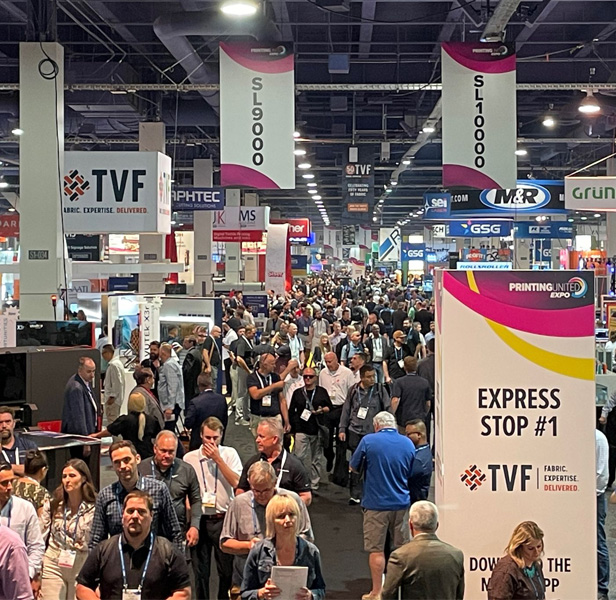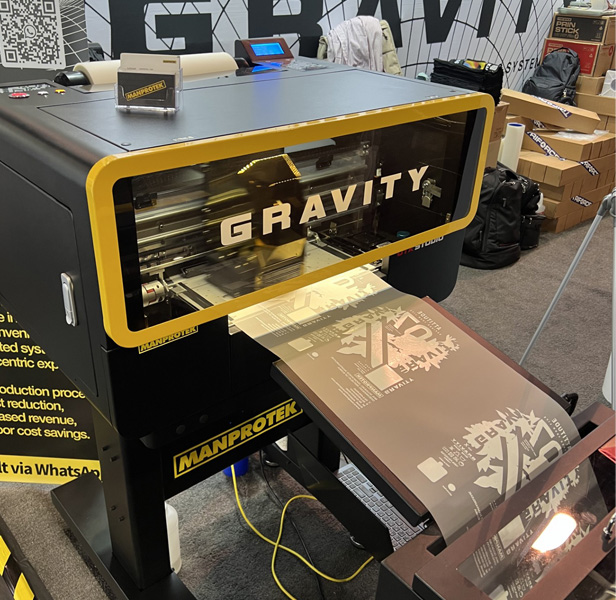Strategy September 11, 2024
PRINTING United Expo 2024: Maintaining Margins With Print-On-Demand
As print-on-demand orders become more common, decorators and distributors are finding the value of direct-to-film and direct-to-garment printing, according to panelists at the massive print industry trade show.
We live in a society where we can get everything within a few clicks. We expect things fast because we’ve grown accustomed to everything being fast.
A combination of technological advancements in print, allowing for decorating much more than just apparel, as well as technological advancements in society creating an internet age where anyone can have a storefront or sell branded merchandise, means that print is not only the future for a lot of branded merchandise sellers, it’s also the present.
To that point: Cassie Green, content director for the Apparelist publication within PRINTING United Alliance, oversaw a panel on day one (Sept. 10) of the PRINTING United Expo in Las Vegas with a group of decorators and distributors who focus heavily on print-on-demand (POD) in their businesses: Deana Iribe, owner, The Print Bakery, DTG Connection; Travis Ross, host of Print On Demand Cast and owner of Make Your Mark Designs; and Davis Slagle, vice president, BeeGraphix.

The show floor was bustling on the first day of PRINTING United Expo, where professional education sessions included the engaging panel discussion on print-on-demand.
The panel explored the idea that the current POD boom came as a result of the pandemic, where people started selling more than just T-shirts printed on demand but also items like drinkware, realizing the potential for direct-to-film (DTF) decoration and the opportunity it presented for other products they could sell customers without having to invest in more equipment or house a ton of products.
“Before the pandemic, apparel was really kind of the king,” Ross said. “I would say it’s probably still the king, but you’re seeing a lot of unique products being offered as print-on-demand.”
Ross believes that we’re still in the infancy of the POD boom, too, with more and more companies seeing the appeal of DTF printing rather than direct-to-garment (DTG) or screen printing.
Iribe said DTF is starting to appeal to decorators due to the ability to handle smaller orders and maintain profit margin.

Direct-to-film printers like these are all over the show floor at the PRINTING United Expo.
“We went to DTF due to a lack of bulk orders,” Slagle said. “The decline of people buying, the purchasing habits of their consumers, they didn’t want to spend $50,000 to put stuff in the closet. They wanted to buy 50 pieces when they needed it.”
Those consumer habits prompted BeeGraphix to do away with a lot of their printing equipment in favor of doing those smaller runs of heat presses and DTF decoration jobs.
The Direct-to-Film Revolution
Walking the show floor at PRINTING United, DTF printing is absolutely everywhere.
Just a few years ago, screen printing was the dominant force. And while it’s absolutely still present on the show floor, DTF seems to be gaining ground. Ross asserted that in the apparel and promo decorating industry overall, DTF is starting to usurp screen printing.
“Ten, 15 years ago, almost everyone was screen printing,” he said. “There are so many innovations that have happened in the last 10 years that have changed the industry, and I don’t see it slowing down.”
For him and other panelists, it’s the ability to run full color quickly and with easy customization rather than a four-, five- or six-color job. Decorators can also quickly turn around however many items the customer needs without the risk of dead stock, which benefits their margins.
“It’s a much lower risk cost-wise, doing print-on-demand with DTF,” Iribe said. “When I started doing pop-ups, I did DTG, and I was stuck with items I couldn’t sell.”
With DTF, she found that if she had overprinted designs, she could still apply them to a different product; if the customer wanted an apparel piece, for instance, she could put it on drinkware.
The Sales Strategy
Of course, just having the DTF or DTG printing equipment and the desire to sell isn’t enough to take your business to the next level, Ross said.
For distributors and printers at the beginning of their POD journey, Ross and Slagle recommended finding a specific niche at first and looking for customers within that buying category. Ross used the example of road-biking enthusiasts: look at what they’re already buying and come up with ideas on your own that would work for them.
Slagle said that his company got in with the rugby market and now has four different individually branded subdivisions of the company that sell to specific markets.
“A machine isn’t going to make you any money,” Ross said. “Without a marketing plan, without a business plan or some way to get in front of your client, it really doesn’t matter if you have the latest and greatest equipment or a lot of blank inventory. I think that’s why POD is so advantageous. There’s an ability to test the market at such a low cost.”
Find a Partner
Ross added that it’s not even necessary to own the equipment yourself to begin POD sales. In fact, Slagle believes that it might be a bad idea if you are more on the casual end of the machinery spectrum.
“If you’re not mechanically inclined, do not bring the DTF printer in-house,” he said. “Partner with a fulfillment company and someone who can produce the goods. Start with selling. If you [buy the machine without knowing how to use it], you’re going to be left with a $15-20,000 paperweight and get angry. I would start selling, get a bunch of stores under your belt, build your customer base and then bring it in-house.”
The Fabric Specs
While printers can do DTF for hard goods, apparel is still one of the most popular POD pieces. With that comes the question of what sort of decoration would be best for the product.
Iribe recommended doing DTG printing for softer lightweight products like T-shirts where the customer might want a softer touch, but on heavier items like hoodies DTF is preferable.
DTF, she added, allows for flexibility to decorate any part of the shirt or garment.
Ross said that you could do DTG on the front of a shirt but DTF on the sleeve.
Ultimately, though, Slagle believes that the most granular analysis of the touch and feel of the decoration will come from you, and not the customer.
“Ninety-nine percent of my customers don’t care,” he said. “Does it hold up when it washes? The feel and thickness are much more important to us than 99.9% of the people who get the goods.”
When asked about screen printing versus DTG or DTF in terms of quality, Slagle said that distributors just need to find their “threshold” of where screen printing no longer makes financial sense.
“Is it under 48? Is it under 72? What kind of heat presses do you have?” he said. “Is it under 24? You’re not setting up an auto [screen printer] for under 24 shirts. If you’re arguing over a 24-piece order, the customer probably isn’t worth your time. Find that threshold and take control of the conversation.”
Billed as the most dynamic and comprehensive event for the printing industry in the world, PRINTING United Expo runs Sept. 10-12.
